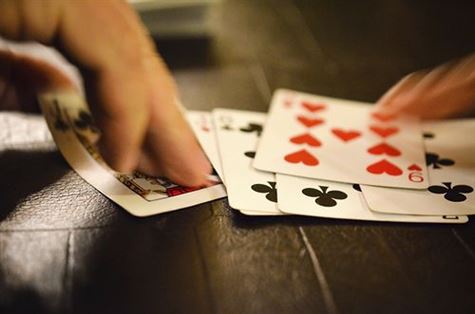Advanced Poker Math: Exploring Combinatorics and Hand Equities is a comprehensive guide that delves into the mathematical aspects of poker. This guide provides an in-depth understanding of combinatorics, which is crucial for calculating hand equities and making informed decisions at the poker table. By exploring advanced concepts and strategies, this guide equips players with the necessary tools to analyze poker hands, assess probabilities, and ultimately improve their overall game.
The Importance of Poker Math in Making Informed Decisions
At its core, poker math involves using probability and statistics to calculate the likelihood of certain outcomes and make decisions based on that information. This can be particularly useful when it comes to understanding the concept of hand equities and combinatorics.
Hand equities refer to the relative strength of a player’s hand compared to their opponents’ hands. By understanding hand equities, players can make more accurate assessments of their chances of winning a hand and adjust their betting accordingly. This is where poker math comes into play.
Combinatorics, on the other hand, is the branch of mathematics that deals with counting and arranging objects. In the context of poker, combinatorics is used to calculate the number of possible combinations of cards that can be dealt in a given situation. This information is crucial for understanding the likelihood of certain hands being dealt and can help players make more informed decisions.
For example, let’s say you are playing Texas Hold’em and you are dealt two cards of the same suit. To calculate the probability of flopping a flush, you would need to know the number of possible combinations of cards that could be dealt on the flop. This can be calculated using combinatorics.
There are 52 cards in a deck, and after you have been dealt your two hole cards, there are 50 cards left in the deck. On the flop, three cards are dealt, so there are 47 cards left in the deck. To calculate the number of possible combinations of cards that could be dealt on the flop, you would use the formula 47 choose 3, which equals 16,215.
Now, let’s say there are nine other players at the table, and you know that none of them have any of the cards of your suit. This means that there are nine cards of your suit left in the deck. To calculate the probability of flopping a flush, you would divide the number of possible combinations of cards that could give you a flush (9 choose 3) by the total number of possible combinations (47 choose 3).
By doing this calculation, you would find that the probability of flopping a flush in this situation is approximately 0.84%. Armed with this information, you can make more informed decisions about whether to continue betting or fold based on the strength of your hand relative to the potential hands your opponents could have.
Understanding poker math and being able to apply it in real-time can give players a significant edge at the poker table. By calculating hand equities and using combinatorics to assess the likelihood of certain outcomes, players can make more informed decisions and increase their chances of winning.
Understanding Combinatorics: A Key Element in Advanced Poker Strategy
One of the fundamental concepts in combinatorics is the concept of permutations and combinations. Permutations refer to the arrangement of objects in a specific order, while combinations refer to the selection of objects without regard to order. In poker, permutations are often used to calculate the number of possible ways a hand can be dealt, while combinations are used to calculate the number of possible ways a specific hand can be made.
For example, let’s consider a standard deck of 52 playing cards. The number of possible permutations of five cards from this deck is calculated using the formula nPr = n! / (n – r)!, where n is the total number of objects and r is the number of objects being selected. In this case, the calculation would be 52P5 = 52! / (52 – 5)! = 52! / 47! = 52 * 51 * 50 * 49 * 48 = 2,598,960. This means that there are 2,598,960 possible ways to deal a five-card hand from a standard deck.
Once players have a grasp of permutations and combinations, they can delve deeper into the world of hand equities. Hand equity refers to the probability of a hand winning against other possible hands. By calculating hand equities, players can make more informed decisions about whether to bet, raise, or fold.
Calculating hand equities involves considering the range of possible hands that opponents may have and comparing them to the player’s own hand. This requires a deep understanding of combinatorics and the ability to calculate the probability of certain hands appearing. By using mathematical formulas and tools, players can estimate their hand’s equity and make strategic decisions accordingly.
For example, let’s say a player is holding a pair of aces in Texas Hold’em. To calculate the hand equity, the player would need to consider the possible hands that opponents may have and calculate the probability of each hand winning against the player’s pair of aces. This calculation involves combinatorics and can be quite complex, but it provides valuable insights into the strength of the player’s hand.
Exploring Hand Equities: Calculating Probabilities for Better Decision Making
To calculate the number of possible combinations, we use the concept of factorials. A factorial is the product of all positive integers less than or equal to a given number. For example, 5 factorial (written as 5!) is equal to 5 x 4 x 3 x 2 x 1, which equals 120.
In poker, we can use factorials to calculate the number of possible combinations of cards. For instance, there are 52 cards in a standard deck, and we are dealt two cards in Texas Hold’em. To calculate the number of possible combinations, we use the formula 52! / (2! x (52-2)!), which simplifies to 52 x 51 / 2, resulting in 1,326 possible combinations.
Understanding combinatorics allows us to calculate the probability of being dealt specific hands. For example, the probability of being dealt pocket aces (two aces as your hole cards) is 4/1,326, or approximately 0.3%. This knowledge helps us assess the strength of our starting hand and make better decisions based on the likelihood of winning.
Hand equity is another crucial concept in poker math. It refers to the share of the pot that a player expects to win on average based on the strength of their hand. Calculating hand equity allows players to determine the profitability of their decisions and make more informed choices.
To calculate hand equity, we need to consider the range of hands our opponents might have. By assigning a range of hands to each opponent, we can calculate the probability of winning against each possible hand. This information helps us estimate our overall equity in the hand.
For example, if we have a flush draw (four cards of the same suit) on the flop, and our opponent has a set (three of a kind), we can calculate our equity by considering the remaining cards in the deck that could complete our flush. If there are nine cards of the same suit remaining, we have approximately a 35% chance of completing our flush and winning the hand.
Calculating hand equity allows us to make better decisions based on the potential profitability of our actions. If our equity is high, it may be wise to invest more chips in the pot. Conversely, if our equity is low, it may be prudent to fold and minimize our losses.
Advanced Techniques in Poker Math: Applying Combinatorics to Hand Ranges
To apply combinatorics to hand ranges, you need to consider the number of possible starting hands in poker. In Texas Hold’em, for example, there are a total of 1,326 possible starting hand combinations. This number can be calculated by multiplying the number of possible hole cards (52) by the number of ways to choose two cards from a deck of 52 (52 choose 2).
Once you understand the total number of possible starting hands, you can begin to narrow down your opponents’ ranges based on their actions and the community cards. For example, if a player raises preflop, you can eliminate certain hands from their range, such as low pocket pairs or weak suited connectors.
Calculating hand equities is another important aspect of advanced poker math. Hand equity refers to the percentage chance of winning a hand at a given point in the game. By calculating hand equities, you can determine the strength of your hand relative to your opponents’ hands and make more informed decisions.
To calculate hand equities, you can use various software programs or online calculators. These tools take into account the range of hands for each player and simulate thousands of hands to determine the likelihood of winning. By inputting the community cards and your opponents’ likely ranges, you can get a clear picture of your hand’s equity.
Understanding hand equities can help you make better decisions in situations such as whether to call a bet, raise, or fold. For example, if you have a flush draw on the turn and your opponent bets, you can calculate your hand’s equity to determine whether it is profitable to call the bet based on the pot odds.
By combining combinatorics and hand equities, you can gain a deeper understanding of the game and improve your overall strategy. For example, if you know that your opponent’s range is heavily weighted towards strong hands, you can adjust your strategy accordingly by playing more cautiously or bluffing less frequently.
It’s important to note that while advanced poker math can be a powerful tool, it should not be relied upon exclusively. Poker is a dynamic game, and factors such as table dynamics, player tendencies, and position also play a significant role in decision-making.
Mastering Poker Math: Enhancing Your Skills in Combinatorics and Hand Equities
To illustrate this concept, let’s consider a simple example. In Texas Hold’em, each player is dealt two private cards, and five community cards are placed on the table. The total number of possible combinations of hands that can be dealt is calculated using combinatorics. There are 52 cards in a deck, and we choose 2 cards for each player. The formula for calculating combinations is nCr = n! / (r!(n-r)!), where n is the total number of objects and r is the number of objects chosen. Applying this formula, we find that there are 1,326 possible combinations of hands that can be dealt in Texas Hold’em.
Understanding combinatorics allows you to assess the likelihood of your opponents holding certain hands. For example, if you have a pair of aces, you know that there are only six possible combinations of hands that can beat you (AA, KK, QQ, JJ, TT, and AK). This knowledge can help you make informed decisions about your betting strategy.
Hand equity is another important concept in advanced poker math. It refers to the percentage chance of winning a hand at a particular point in the game. Calculating hand equity involves considering the range of hands your opponents could have and comparing it to your own hand.
To calculate hand equity, you can use various tools and software available online. These tools take into account the range of hands your opponents could have based on their actions and the community cards on the table. By inputting your hand and the range of hands your opponents could have, you can get an estimate of your hand equity.
Understanding hand equity allows you to make more accurate decisions about whether to bet, call, or fold. For example, if you have a flush draw on the turn, and your hand equity is 30%, you can compare this to the pot odds to determine whether it is profitable to continue with the hand.
Mastering combinatorics and hand equities requires practice and study. There are numerous resources available, including books, articles, and online forums, where you can learn more about these concepts. Additionally, many professional players offer courses and coaching sessions to help you improve your understanding of advanced poker math.
In conclusion, advanced poker math is a crucial aspect of becoming a successful poker player. Understanding combinatorics allows you to assess the strength of your hand relative to your opponents’, while hand equity helps you make informed decisions about your betting strategy. By studying and practicing these concepts, you can enhance your skills and gain a significant edge at the poker table. So, dive into the world of advanced poker math and take your game to the next level.




